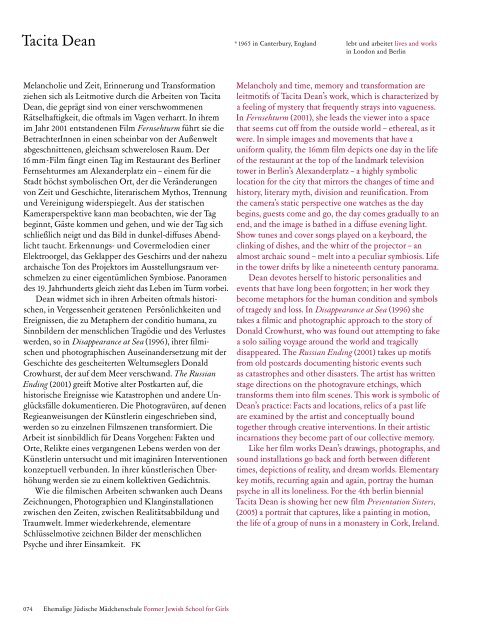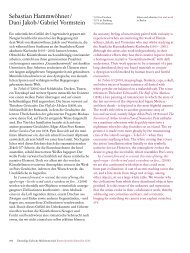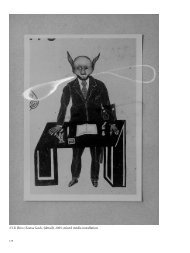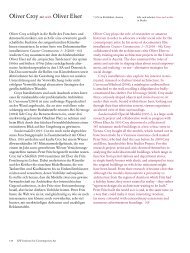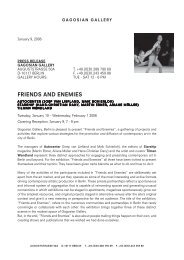Tacita Dean - 4th berlin biennial for contemporary art
Tacita Dean - 4th berlin biennial for contemporary art
Tacita Dean - 4th berlin biennial for contemporary art
Sie wollen auch ein ePaper? Erhöhen Sie die Reichweite Ihrer Titel.
YUMPU macht aus Druck-PDFs automatisch weboptimierte ePaper, die Google liebt.
<strong>Tacita</strong> <strong>Dean</strong> * 1965 in Canterbury, England lebt und arbeitet lives and works<br />
in London and Berlin<br />
Melancholie und Zeit, Erinnerung und Trans<strong>for</strong>mation<br />
ziehen sich als Leitmotive durch die Arbeiten von <strong>Tacita</strong><br />
<strong>Dean</strong>, die geprägt sind von einer verschwommenen<br />
Rätselhaftigkeit, die oftmals im Vagen verharrt. In ihrem<br />
im Jahr 2001 entstandenen Film Fernsehturm führt sie die<br />
BetrachterInnen in einen scheinbar von der Außenwelt<br />
abgeschnittenen, gleichsam schwerelosen Raum. Der<br />
16 mm - Film fängt einen Tag im Restaurant des Berliner<br />
Fernsehturmes am Alexanderplatz ein – einem für die<br />
Stadt höchst symbolischen Ort, der die Veränderungen<br />
von Zeit und Geschichte, literarischem Mythos, Trennung<br />
und Vereinigung widerspiegelt. Aus der statischen<br />
Kameraperspektive kann man beobachten, wie der Tag<br />
beginnt, Gäste kommen und gehen, und wie der Tag sich<br />
schließlich neigt und das Bild in dunkel-diffuses Abend-<br />
licht taucht. Erkennungs- und Covermelodien einer<br />
Elektroorgel, das Geklapper des Geschirrs und der nahezu<br />
archaische Ton des Projektors im Ausstellungsraum ver-<br />
schmelzen zu einer eigentümlichen Symbiose. Panoramen<br />
des 19. Jahrhunderts gleich zieht das Leben im Turm vorbei.<br />
<strong>Dean</strong> widmet sich in ihren Arbeiten oftmals historischen,<br />
in Vergessenheit geratenen Persönlichkeiten und<br />
Ereignissen, die zu Metaphern der conditio humana, zu<br />
Sinnbildern der menschlichen Tragödie und des Verlustes<br />
werden, so in Disappearance at Sea (1996 ), ihrer filmi-<br />
schen und photographischen Auseinandersetzung mit der<br />
Geschichte des gescheiterten Weltumseglers Donald<br />
Crowhurst, der auf dem Meer verschwand. The Russian<br />
Ending (2001) greift Motive alter Postk<strong>art</strong>en auf, die<br />
historische Ereignisse wie Katastrophen und andere Unglücksfälle<br />
dokumentieren. Die Photogravüren, auf denen<br />
Regieanweisungen der Künstlerin eingeschrieben sind,<br />
werden so zu einzelnen Filmszenen trans<strong>for</strong>miert. Die<br />
Arbeit ist sinnbildlich für <strong>Dean</strong>s Vorgehen: Fakten und<br />
Orte, Relikte eines vergangenen Lebens werden von der<br />
Künstlerin untersucht und mit imaginären Interventionen<br />
konzeptuell verbunden. In ihrer künstlerischen Über-<br />
höhung werden sie zu einem kollektiven Gedächtnis.<br />
Wie die filmischen Arbeiten schwanken auch <strong>Dean</strong>s<br />
Zeichnungen, Photographien und Klanginstallationen<br />
zwischen den Zeiten, zwischen Realitätsabbildung und<br />
Traumwelt. Immer wiederkehrende, elementare<br />
Schlüsselmotive zeichnen Bilder der menschlichen<br />
Psyche und ihrer Einsamkeit. FK<br />
074 Ehemalige Jüdische Mädchenschule Former Jewish School <strong>for</strong> Girls<br />
Melancholy and time, memory and trans<strong>for</strong>mation are<br />
leitmotifs of <strong>Tacita</strong> <strong>Dean</strong>’s work, which is characterized by<br />
a feeling of mystery that frequently strays into vagueness.<br />
In Fernsehturm (2001), she leads the viewer into a space<br />
that seems cut off from the outside world – ethereal, as it<br />
were. In simple images and movements that have a<br />
uni<strong>for</strong>m quality, the 16mm film depicts one day in the life<br />
of the restaurant at the top of the landmark television<br />
tower in Berlin’s Alexanderplatz – a highly symbolic<br />
location <strong>for</strong> the city that mirrors the changes of time and<br />
history, literary myth, division and reunification. From<br />
the camera’s static perspective one watches as the day<br />
begins, guests come and go, the day comes gradually to an<br />
end, and the image is bathed in a diffuse evening light.<br />
Show tunes and cover songs played on a keyboard, the<br />
clinking of dishes, and the whirr of the projector – an<br />
almost archaic sound – melt into a peculiar symbiosis. Life<br />
in the tower drifts by like a nineteenth century panorama.<br />
<strong>Dean</strong> devotes herself to historic personalities and<br />
events that have long been <strong>for</strong>gotten; in her work they<br />
become metaphors <strong>for</strong> the human condition and symbols<br />
of tragedy and loss. In Disappearance at Sea (1996) she<br />
takes a filmic and photographic approach to the story of<br />
Donald Crowhurst, who was found out attempting to fake<br />
a solo sailing voyage around the world and tragically<br />
disappeared. The Russian Ending (2001) takes up motifs<br />
from old postcards documenting historic events such<br />
as catastrophes and other disasters. The <strong>art</strong>ist has written<br />
stage directions on the photogravure etchings, which<br />
trans<strong>for</strong>ms them into film scenes. This work is symbolic of<br />
<strong>Dean</strong>’s practice: Facts and locations, relics of a past life<br />
are examined by the <strong>art</strong>ist and conceptually bound<br />
together through creative interventions. In their <strong>art</strong>istic<br />
incarnations they become p<strong>art</strong> of our collective memory.<br />
Like her film works <strong>Dean</strong>’s drawings, photographs, and<br />
sound installations go back and <strong>for</strong>th between different<br />
times, depictions of reality, and dream worlds. Elementary<br />
key motifs, recurring again and again, portray the human<br />
psyche in all its loneliness. For the <strong>4th</strong> <strong>berlin</strong> <strong>biennial</strong><br />
<strong>Tacita</strong> <strong>Dean</strong> is showing her new film Presentation Sisters,<br />
(2005) a portrait that captures, like a painting in motion,<br />
the life of a group of nuns in a monastery in Cork, Ireland.
Presentation Sisters, 2005, film stills<br />
075
<strong>Tacita</strong> <strong>Dean</strong><br />
*1965 in Canterbury Lebt und arbeitet Lives and works in Berlin<br />
EINZELAUSSTELLUNGEN SOLO EXHIBITIONS<br />
2006 Schaulager, Basel<br />
2004 De Pont Museum of Contemporary Art, Tilburg, The Netherlands<br />
2003 Marian Goodman Gallery, New York<br />
2002 Museo Serralves, Porto<br />
2001 Tate Britain, London<br />
GRUPPENAUSSTELLUNGEN GROUP EXHIBITIONS<br />
2006 15th Biennale of Sydney<br />
2005 La Biennale di Venezia, 51. Esposizione Internazionale d’Arte<br />
2004 Arte Povera, Museet <strong>for</strong> Samtidskunst, Oslo<br />
2003 The Moderns, Castello di Rivoli Museo d’Arte Contemporanea, Turin<br />
– Fast Forward: Media Art from the Goetz Collection, ZKM Museum für<br />
Neue Kunst, Karlsruhe<br />
PUBLIKATIONEN PUBLICATIONS<br />
– <strong>Tacita</strong> <strong>Dean</strong>, Berlin Works, (ex. cat.) Tate St. Ives, Cornwall, 2005<br />
– <strong>Tacita</strong> <strong>Dean</strong>, Seven Books, (ex. cat.) Musée d’Art Moderne de la<br />
Ville de Paris, 2003<br />
– <strong>Tacita</strong> <strong>Dean</strong>, (ex. cat.) Tate Britain, London, 2001<br />
– <strong>Tacita</strong> <strong>Dean</strong>, Recent Films and Other Works, (ex. cat.) Museu d’Art<br />
Contemporani de Barcelona, 2001<br />
– <strong>Tacita</strong> <strong>Dean</strong>, Floh, London: Steidl, 2001


